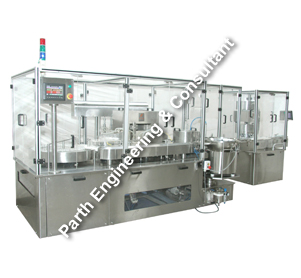In pharmaceutical manufacturing, accuracy and reliability are not optional-they are essential. Whether you're handling injectable powders or sterile liquids, choosing the right vial filling machine can define the success of your production line. With multiple options like injectable powder vial filling lines, injectable liquid vial filling lines and automatic vial filling & stoppering machines, selecting the right system requires a clear understanding of your product type, output needs, regulatory standards and budget.
This guide explores the key considerations when selecting the ideal vial filling equipment, with insights into how different types of vial filling systems work and where they perform best.
Types of Vial Filling Machines
When it comes to vial filling, there are three core categories based on the form of the injectable product:
1. Injectable Powder Vial Filling Line
Used for dry injectable formulations such as antibiotics or freeze-dried biologics.These systems are equipped with servo-driven auger filling technology, ensuring precise fill weights and minimal product loss.
2. Injectable Liquid Vial Filling Line
Designed for sterile liquid pharmaceuticals like vaccines, saline or insulin. These lines use peristaltic pumps or piston pumps for accurate, contamination-free filling.
3. Automatic Vial Filling & Stoppering Machine
These integrated systems fill and stopper vials in a single pass, reducing handling and maintaining aseptic conditions. Available as both semi-automatic and fully automatic machines these systems boost efficiency and sterility.
Understanding which machine fits your formulation is the first step in making the right choice for your requirements.

Production Scale and Injectable Vial Filling Line Configuration
One of the most important considerations is your current and future production needs. Small-scale operations may find a semi-automatic vial filling machine sufficient, while large-scale manufacturers typically require automatic vial filling lines.
Consider:
- Batch size per shift.
- Number of vial sizes you handle.
- Potential for line expansion.
A modular design allows you to expand your line as production demands increase. High-volume operations benefit from rotary systems that support continuous motion and can integrate with washers, sterilizers and cappers.
Precision Requirements in an Injection Vial Filling Machine
For sterile injectable products, even a slight deviation in fill volume can result in product rejection or regulatory issues. That’s why the accuracy of your injection vial filling machine meet stringent tolerances.
Modern systems like the servo-based automatic vial filling machine ensure:
- ±1% or better fill weight accuracy.
- Dynamic motion filling for uniform dosing.
- High-speed operation without compromising quality.
Liquid Vial Filling & Stoppering Machine Integration
In aseptic production, the vial filling process must seamlessly integrate stoppering to maintain sterility. Choosing a vial filling and stoppering machine with a proven track record is essential for pharma-grade operations.
Look for machines with:
- Vacuum-assisted rubber stoppering for sterile environments.
- Integrated vial handling systems to reduce glass-to-glass contact.
- Flexible stopper feeding systems to suit various stopper designs.
The goal is not only accurate filling but also precision stoppering under aseptic conditions.
Pharmaceutical Vial Filling Equipment Material Build Quality
Your pharmaceutical vial filling equipment should be built from pharmaceutical-grade materials to ensure product safety and ease of cleaning. High-quality vial filling machine manufacturers use smooth surfaces and minimal crevices.
Key features to prioritize:
- Easy disassembly for CIP/SIP (Clean-In-Place / Sterilize-In-Place).
- Electropolished contact parts.
- Transparent guarding for visual monitoring.
Build quality directly impacts the longevity, compliance and maintenance frequency of your machine.
Integration of the Vial Filling System with Upstream and Downstream Equipment
Today's production lines are rarely standalone. Your chosen vial filling system should integrate seamlessly with upstream and downstream units such as:
- Vial washers and tunnel sterilizers.
- Cap sealing and crimping machines.
- Visual inspection or leak detection systems.
- Labeling and secondary packaging units.
This integration helps streamline production and reduces the need for manual handling.
Ease of Use in a Modern Vial Filling Machine
Whether you choose a manual, semi-automatic or automatic vial filling machine, operator interface and safety features matter. Modern machines are equipped with intuitive HMIs, safety interlocks and alarms.
Look for:
- Easy disassembly for CIP/SIP (Clean-In-Place / Sterilize-In-Place).
- Automatic jam detection.
- Minimal changeover time between products
Ease of operation minimizes training needs and enhances productivity, particularly in high-turnover environments.
Conclusion
Selecting the vial filling machine-whether it’s for injectable powders, sterile liquids or combination systems with stoppering-requires a deep understanding of your product, production volume and future scalability. From injectable powder vial filling lines to automatic liquid vial filling and stoppering machines, each system serves a unique role in pharmaceutical manufacturing.
FAQs About Vial Filling Machine
An injectable powder vial filling line is designed for dry powder products, using auger or vacuum-based filling. A liquid vial filling line handles sterile liquids using pumps like peristaltic or piston types.
Yes, machines like the automatic vial filling and stoppering machine combine both processes in one unit, improving efficiency and maintaining aseptic conditions.
Yes, rotary and fully automatic vial filling systems are specifically built to handle large batches with consistent speed and minimal human intervention.










